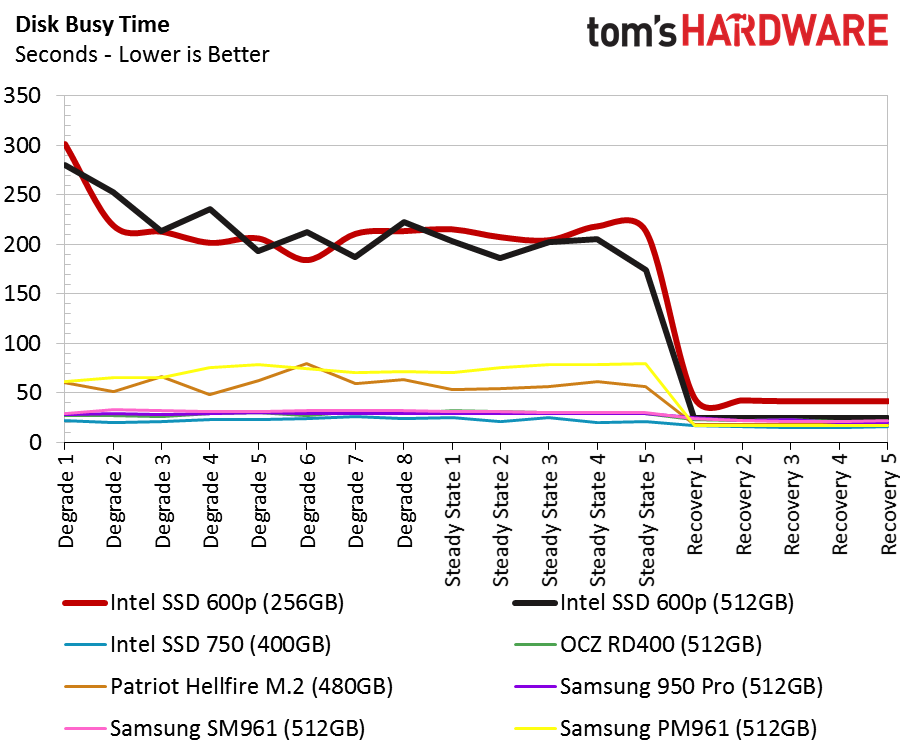Intel 600p Series SSD Review
Why you can trust Tom's Hardware
Comparisons And Benchmarks
Comparison Products
All of the products in the test pool use the NVMe protocol. We managed to scrape together every consumer NVMe SSD in the 512GB-class for this review, but there are some points we need to cover before we dive into testing.
The Patriot Hellfire 480GB appears in our tests with the launch firmware, but we are currently testing a new version that increases performance. The new 2.1 firmware should launch to customers in a few days after this review goes online. The Hellfire is more expensive than the Intel 600p, but it is a fierce competitor.
Three Samsung V-NAND NVMe SSDs from both the retail and OEM divisions made the list. The 950 Pro 512GB is the retail entrant, and the OEM SM961 (MLC) and PM961 (TLC) give us an indication of performance with both current and projected products.
The OCZ RD400 512GB, which is the retail OCZ-branded version of Toshiba's OEM XG3, also made the cut. The RD400 is a capable high-performance consumer SSD, but it has a higher price than many of the other products. Intel's 750 Series 400GB is the only add-in card (AIC) NVMe SSD in the comparison.
We have the 256GB and the 512GB Intel 600p SSDs in for testing. We used with the Windows 8.1 NVMe driver during most of our tests, but the Notebook Battery Life test uses our Lenovo Y700 testbed with Windows 10 Pro.
Many of our readers have requested performance comparisons with the Intel 600p and high-performance SATA products. We added a few important real world and synthetic tests at the bottom of the page to provide comparative data.
Sequential Read Performance
To read about our storage tests in-depth, please check out How We Test HDDs And SSDs. Four-corner testing is covered on page six of our How We Test guide.
Get Tom's Hardware's best news and in-depth reviews, straight to your inbox.


The new Intel 600p NVMe SSD isn't going to win any performance awards compared to other NVMe products. The 600p is a pure value play by Intel. The sequential read performance with a single outstanding request is just under 500 MB/s. The performance increases beyond what SATA 6Gb/s can deliver at QD2, but it is still much less than most of the other NVMe SSDs available.
Sequential Write Performance


The sequential write test reveals that all of the NVMe drives hold a steady line as the queue depth increases. The 600p's average performance is better than a SATA SSD, but much of the throughput comes from the test running in the SLC cache.


Performance gets ugly when the 128KB sequential write workload extends beyond the size of the SLC cache buffer. The 600p doesn't use a direct-to-die algorithm, so all write traffic must pass through the SLC buffer before it rolls into the TLC area. To the end user, the results we see above would average out while transferring data to the 600p's TLC flash. The HD Tune result shows significant performance variation, but the 256GB drive should deliver close to 115 MB/s of throughput (more than enough to saturate a gigabit Ethernet connection). The beefier 512GB 600p offers increased sequential write performance of roughly 170 MB/s.
Random Read Performance



The 600p's QD1 random read performance lags significantly being the rest of the test pool. Several SATA products deliver higher performance at this important benchmark - and not just the high-performance models. NVMe products have, until now, always delivered greater than 10,000 random read IOPS at QD1.
Random Write Performance



The 600p 512GB fares much better during the random write tests at low queue depths. Even though the 512GB falls to the lower end of chart compared to products with the same capacity, the deficit is smaller than the chasm we observed in the previous test.
80 Percent Mixed Sequential Workload
We describe our mixed workload testing in detail here, and describe our steady state tests here.
NVMe SSDs have produced some of the most impressive mixed workload results we've ever seen. Older all-in-one RAID products never scaled as rapidly with increased queue depth. The 600p doesn't scale as well in the mixed sequential test because the write data drags down the total score. Both of the new Intel NVMe SSDs deliver better-than-SATA performance, but the chart highlights the clear distinction between high-performance NVMe and entry-level NVMe.
80 Percent Mixed Random Workload
The random mixed workload test allows the 600p's SLC buffer to absorb most of the writes, but even SLC paired with a 6-channel controller isn't enough to kick the Intel 384Gbit TLC flash into high gear.
Sequential Steady-State



IMFT's 3D TLC flash struggles with steady-state workloads regardless of what protocol it sits behind. Even though this new class of products uses NVMe on the front end, some will digress back to SATA-like levels when you push it with difficult workloads.
Random Steady-State
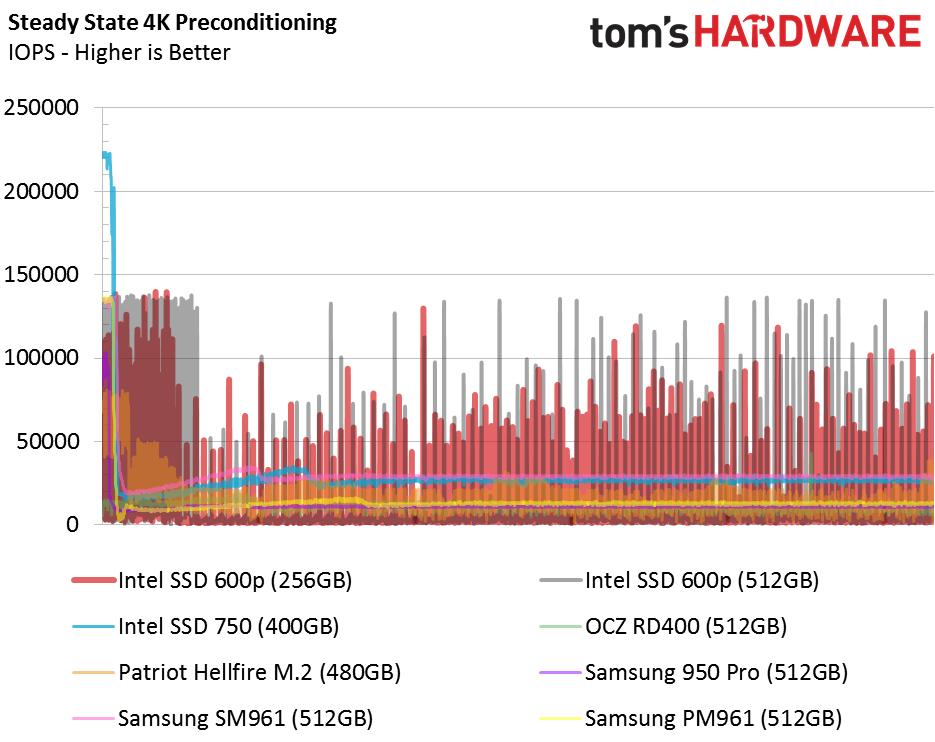

Intel was one of the first companies to preach performance consistency. The rolling tide of commoditized flash results in lower performance across the board. We shouldn’t construe pairing high-performance NVMe with flash designed solely for economies of scale as a great success for enthusiasts and power users. Planar TLC NAND opened new doors for the SSD industry, but it curbed progress on high-performance parts in the process.
Comparing the Intel 750 to the 600p in the consistency chart shows how far we've fallen in so little time.
PCMark 8 Real-World Software Performance
For details on our real-world software performance testing, please click here.






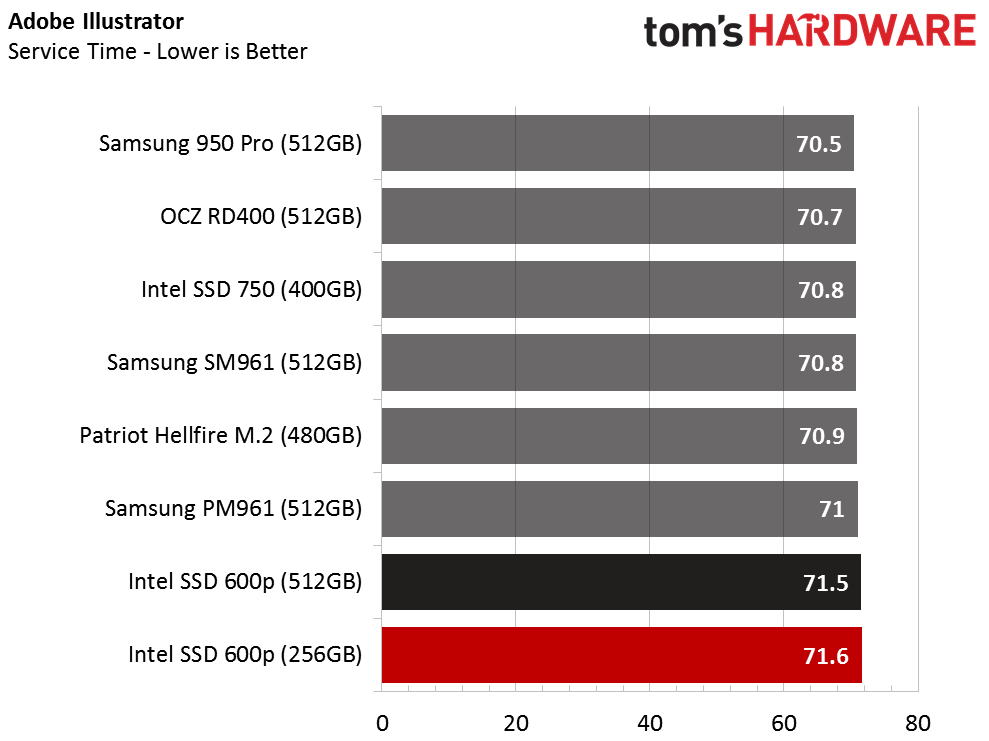

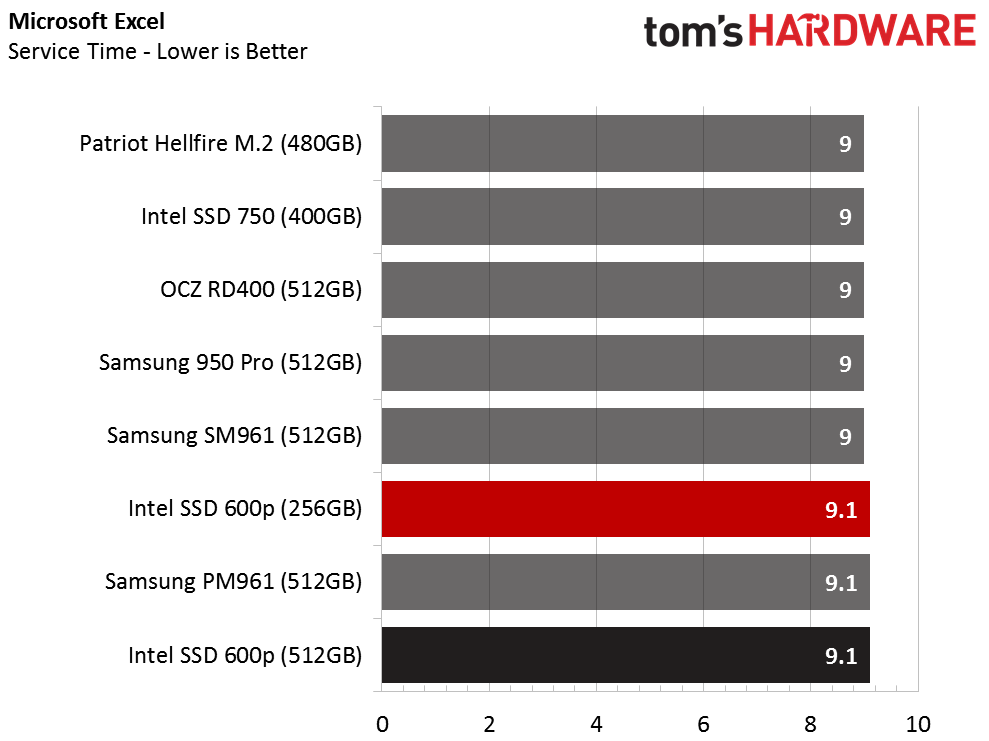
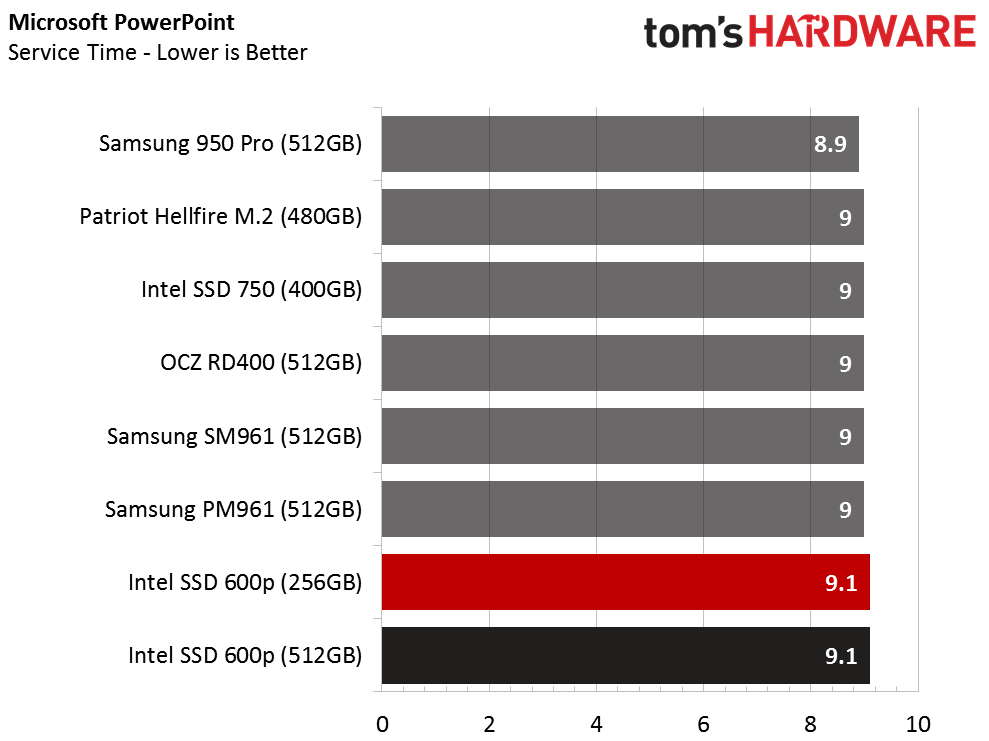
The 600p's real-world performance mimics the difference between high-performance NVMe and SATA products. The 600p is the only product delivering SATA-like results.
Application Storage Bandwidth
We average the test results and present them as a simple throughput score. The result highlights the stark difference between existing NVMe SSDs and the new low-cost Intel 600p. The better-than-SATA synthetic results carry over to the consumer application tests, but the 600p is only slightly better than most enthusiast-class SATA products.
PCMark 8 Advanced Workload Performance
To learn how we test advanced workload performance, please click here.


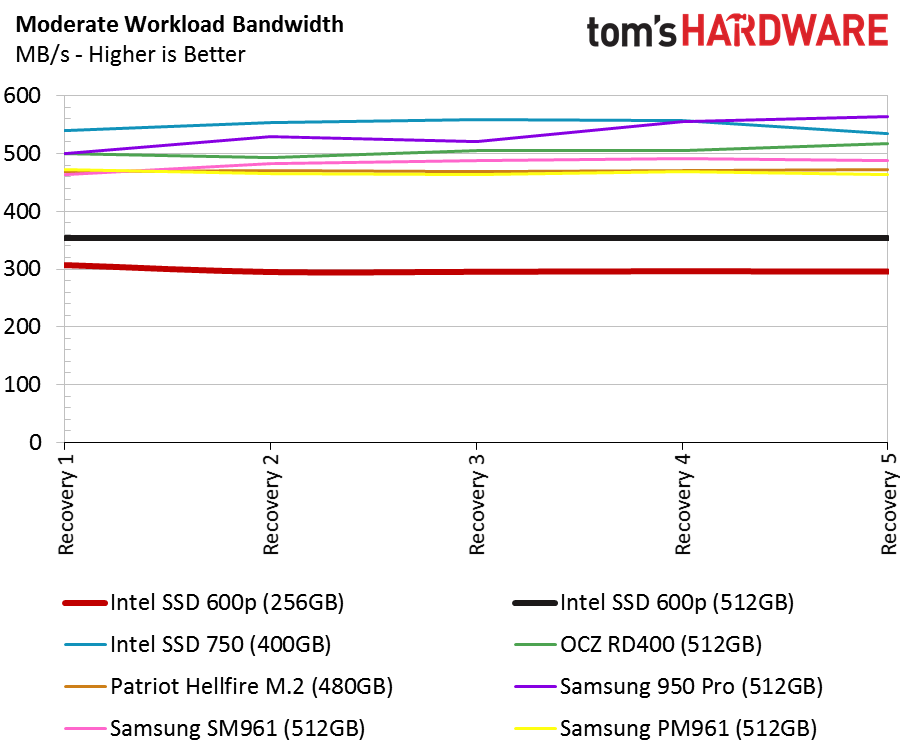
The Intel 600p falls deeper down the charts when we test it with a large amount of data on the flash. We focus on the moderate workloads during the recovery phase, which provides the drive with a copious amount of idle time to restore performance with background operations. The 600p continues to trail every other NVMe product. The 600p also lags far behind the Samsung PM961 that we use to gauge Samsung's upcoming 960 EVO SSD (another low-cost NVMe TLC-based product).
Total Service Time

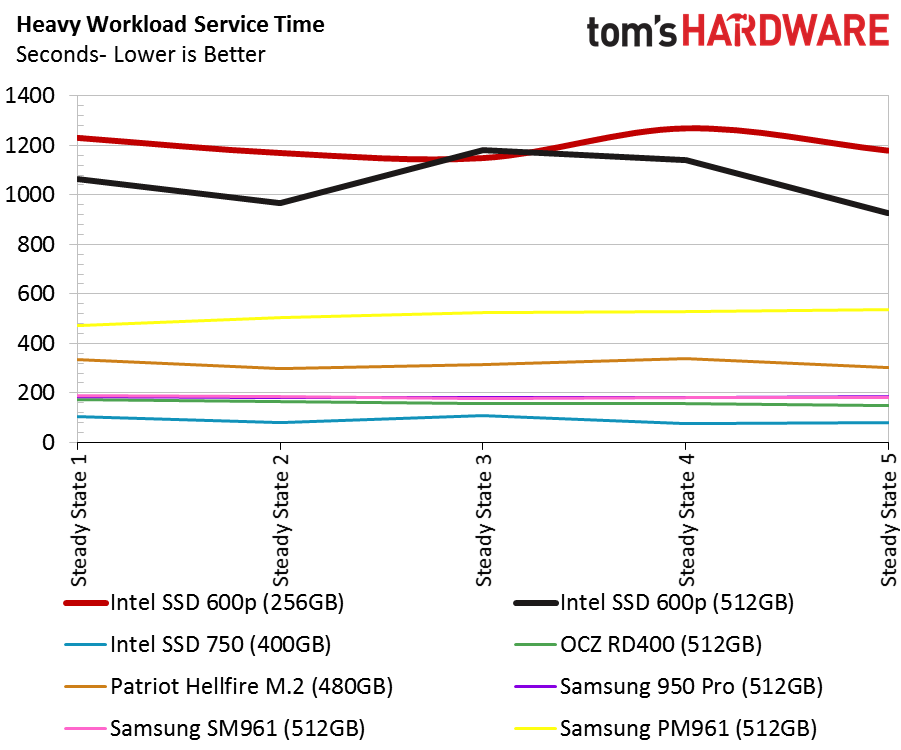

The 600p 512GB results compare well against the other NVMe products with the same capacity during the moderate workload, but the smaller 256GB model is the outlier of the group with much lower performance. The chart also indicates that the new NVMe SSDs perform better than many of the first generation models. The Samsung PM961, Patriot Hellfire and OCZ RD400 deliver the best performance in this important test.
Disk Busy Time
The disk busy time test results are nearly identical to the service time results.
Notebook Battery Life


Most of the NVMe products fall into a tight group during the notebook battery life test. The system restricts the PCIe bus when it is on battery power, which eases power consumption over SATA products. Surprisingly, NVMe SSDs are actually slower on battery power than SATA SSDs. You can configure the PCIe bus to stay in a high-performance state, but the notebook battery life suffers.
Intel 600p vs. SATA







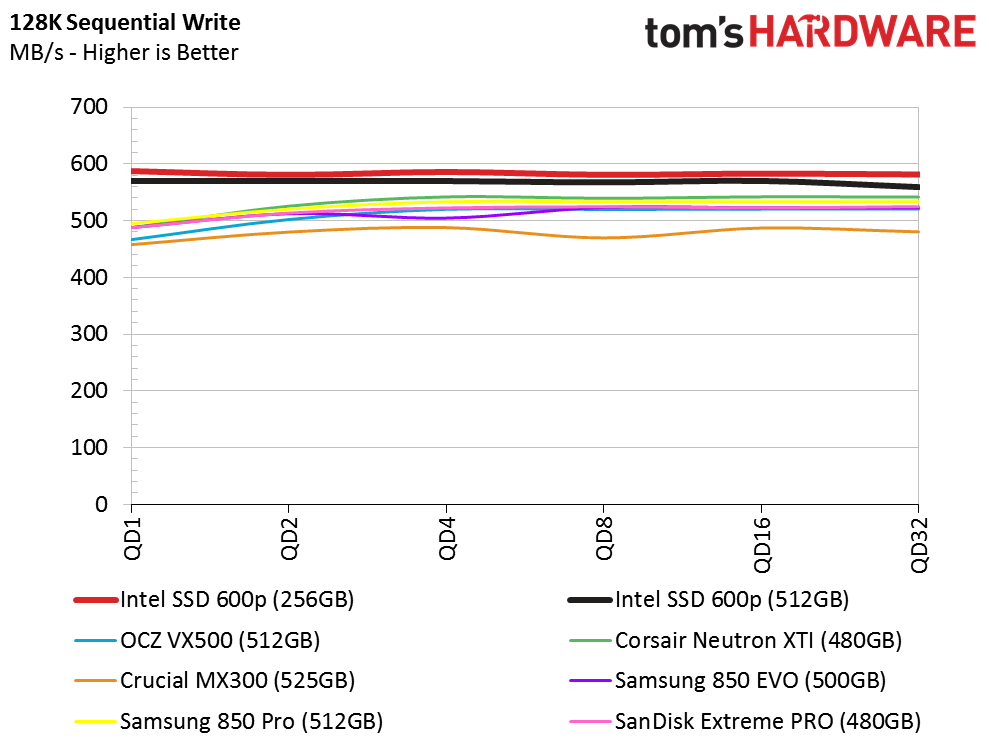











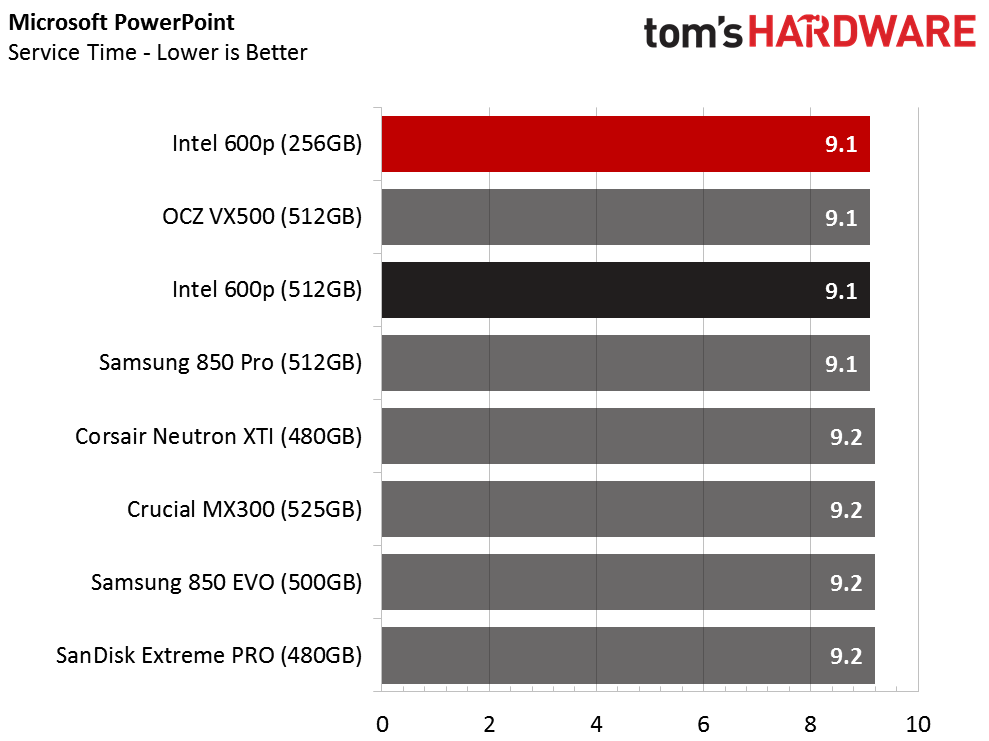



We chose a few key tests to compare the Intel 600p to SATA products to provide a better understanding of where it fits in the overall market. The 600p fares well in most of the tests, but it does not break away from the SATA pack the same way other NVMe products do. If anything, the 600p delivers a slightly better user experience than a premium SATA SSD.
MORE: Best SSDs
MORE: Latest Storage News
MORE: Storage in the Forums

Chris Ramseyer was a senior contributing editor for Tom's Hardware. He tested and reviewed consumer storage.
-
n0ns3ns3 Lol ...Reply
glad I got the much cheaper X400 wth 320 TBW.
Somehow the performance difference (M.2 sata vs PCIe ) isn't that noticeable in real life. Not to mention throttling - which for some reason was not mentioned in review :) -
rgrigio I have a standard 120GB 840 from 2013 alongside with a 1TB HDD on my laptop, paid 120 bucks for it then, and... only 4.60TBW... As long as you use it as a read-drive there isn`t much to be afraid.Reply
Now... if you have a more demanding workload or install/uninstall games every few days, then you should look for another drive.
IMHO it should at least have better performance. This seems "meh"... -
Game256 Intel just can't release a good product for mass market. It's either pricey stuff with high capacity like Intel 750 or garbage like 540s and 600p.Reply
At least 600p is not so overpriced like 540s was (btw the price for 600p is constantly jumping, from 105-130$ for 256 Gb version). At the moment 600p is a good alternative for premium SATA SSD but soon, when there will be more NVMe SSDs on the market and prices fall, 600p will become obsolete. -
philipemaciel Glad there are SATA real world benches in the review! These are very useful for those of us using SATA SDDs and contemplating moving to NVMe.Reply -
tripleX The difference is that your Samsung doesn't self destruct when it passes the endurance limit. Also, since that is early flash I'm sure you have the endurance number wrong.Reply -
Brian_R170 If the not-yet-released 1TB version scales up well, it will be somewhat competitive with the other NVMe offerings and likely a lot cheaper, but as it is, there's not really a lot of reason to buy a 600p.Reply
Of course, the application benchmarks clearly show that the fastest NVMe drives improve your experience by only 1-2% over SATA while costing twice as much, so for most users, there's not a lot of reason to pay extra for NVMe. -
Zaxx420 Intel should not even use 'NVMe' anywhere on the product or packaging...would better keep user's initial expectations in check...everybody associates 'NVMe' with blistering speeds atm. Exceptional job of keeping your conclusion fair with the price being the top consideration. Woulda been REAL easy to unfairly declare this a real turd...tho it does seem Intel coulda done a little better by having direct to die writes at least.Reply -
n0ns3ns3 Reply18618710 said:On further thought... that's only 14tb of data per year. Horrible.
A single game with updates etc can do about 1TB a year. some games are crossing 100GB already.
So while 14TB is indeed a lot, I'd prefer to gave more just to be sure.






